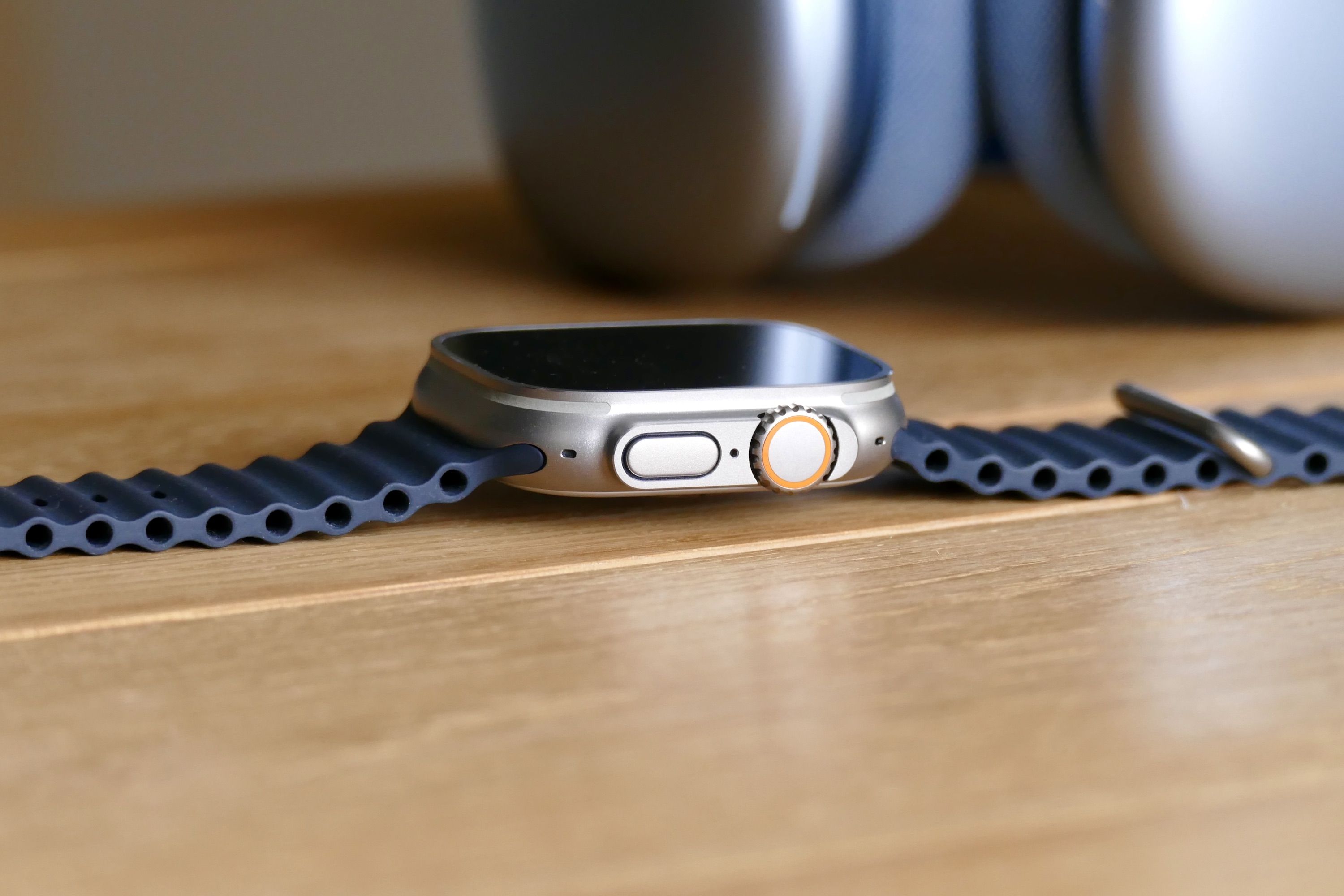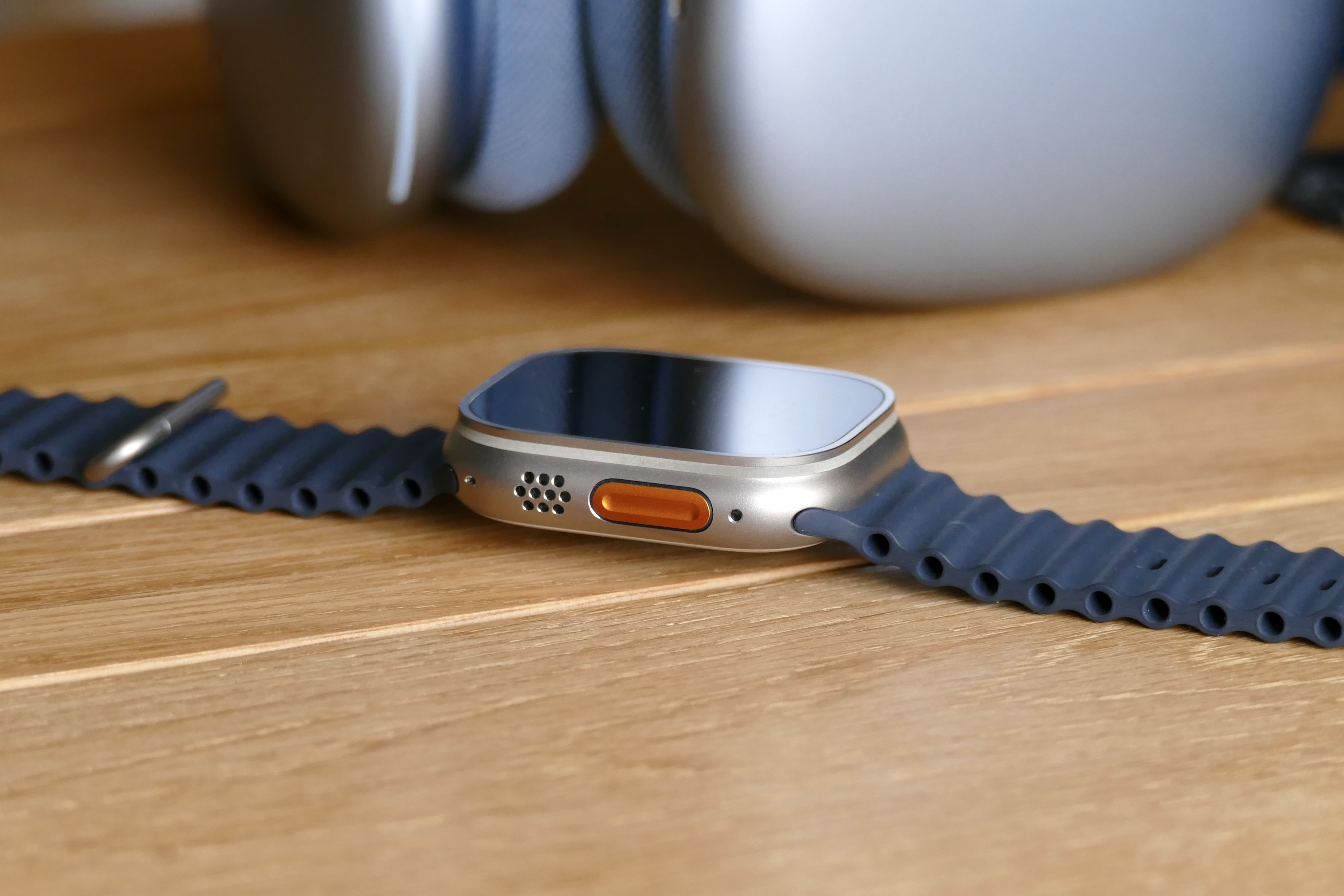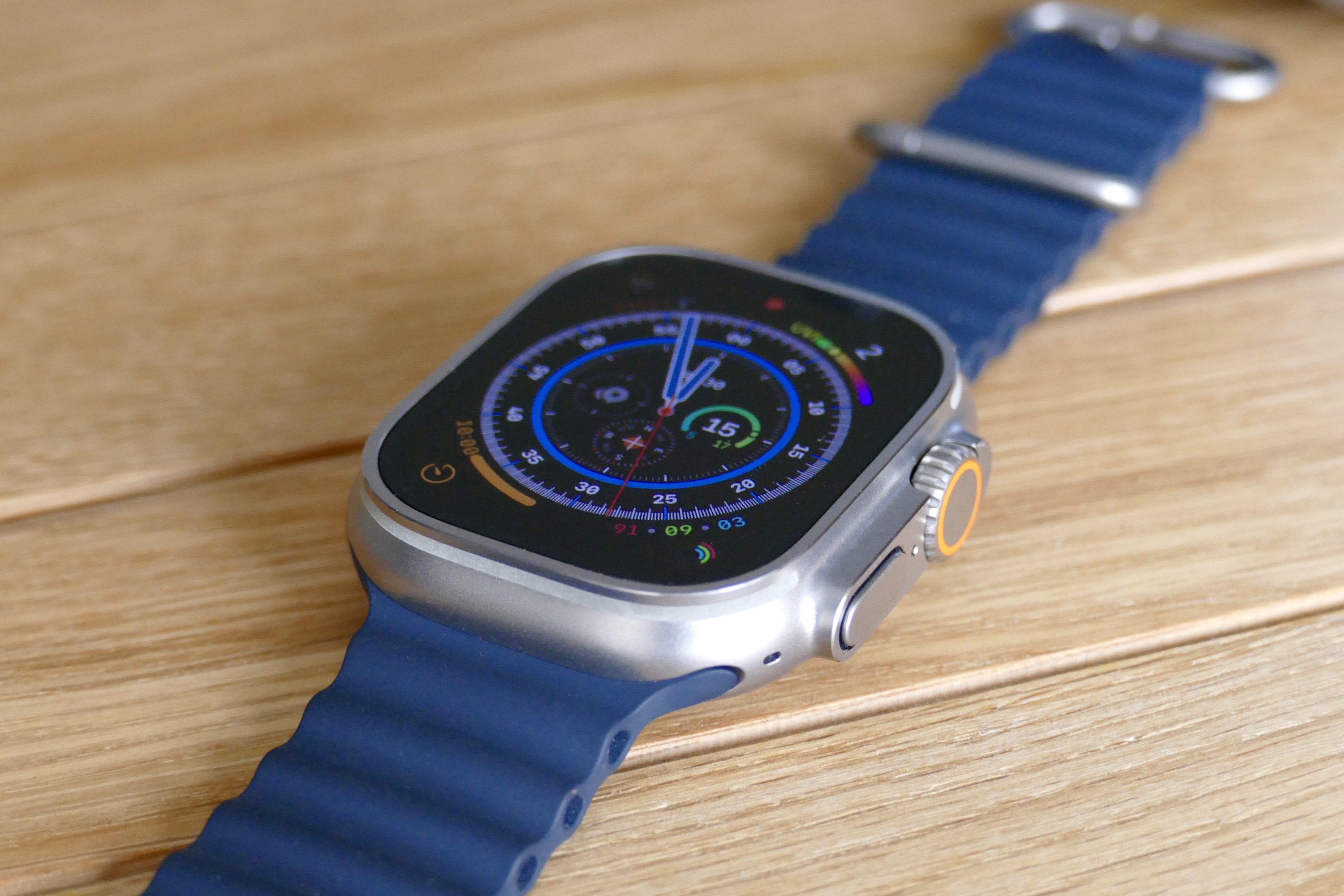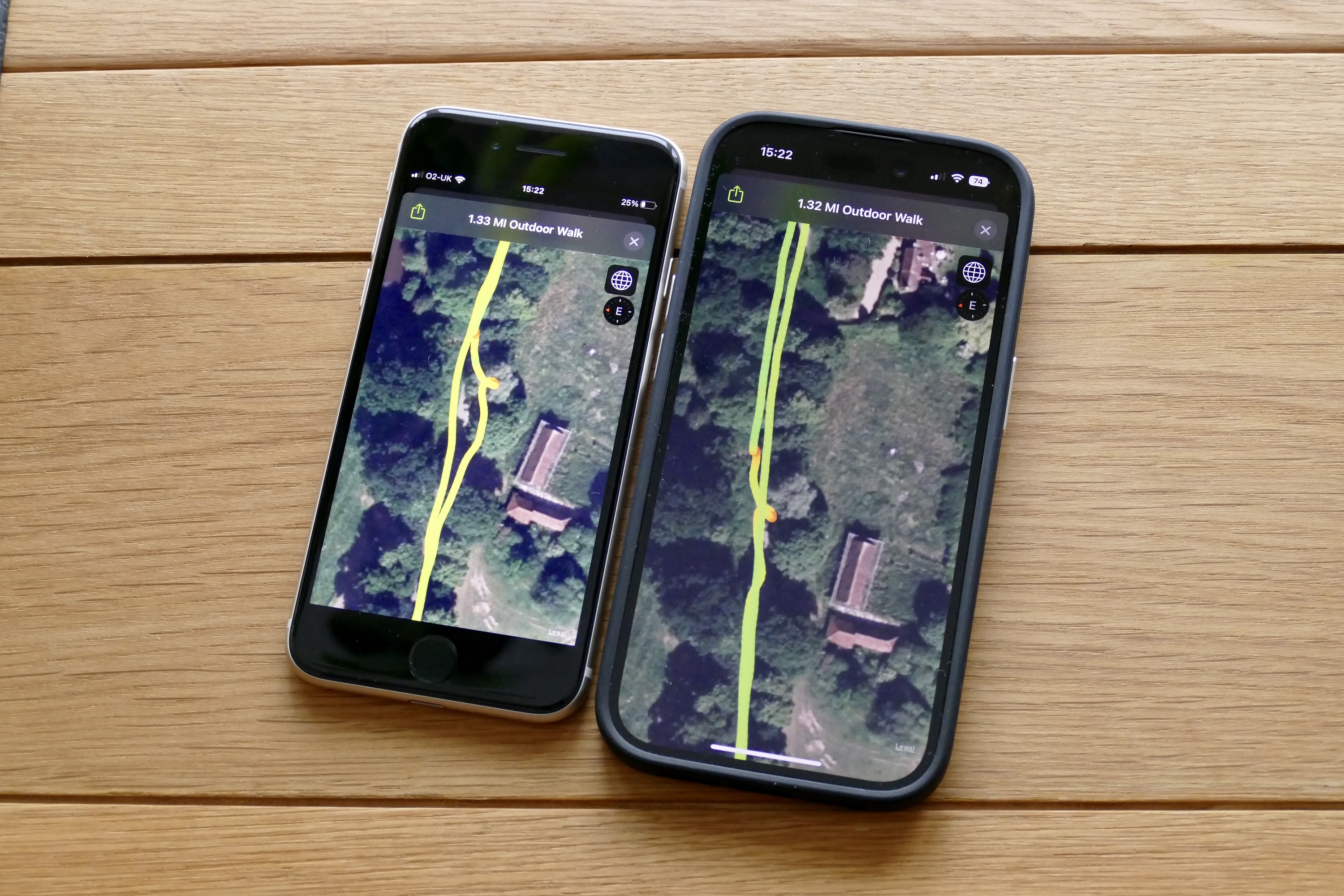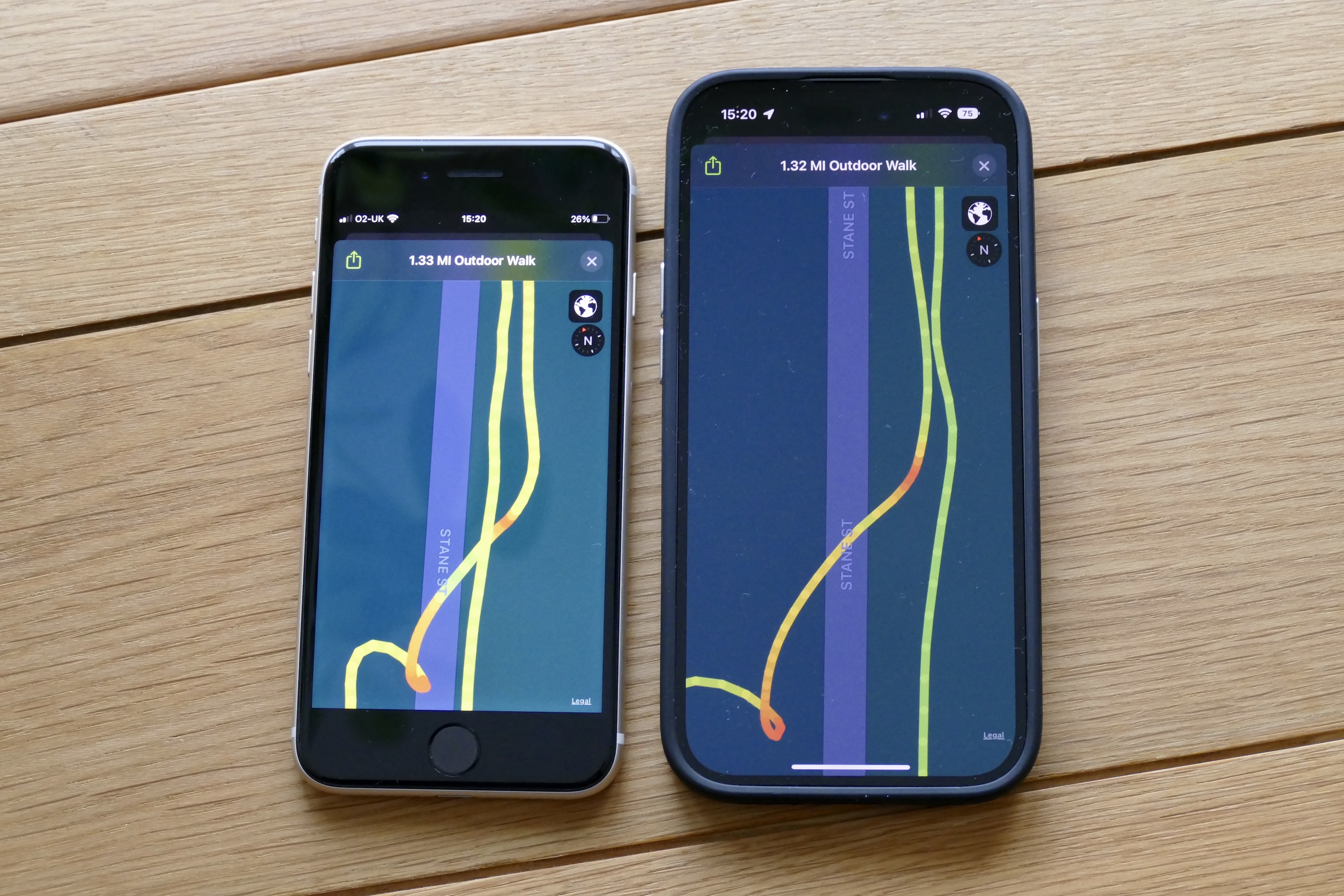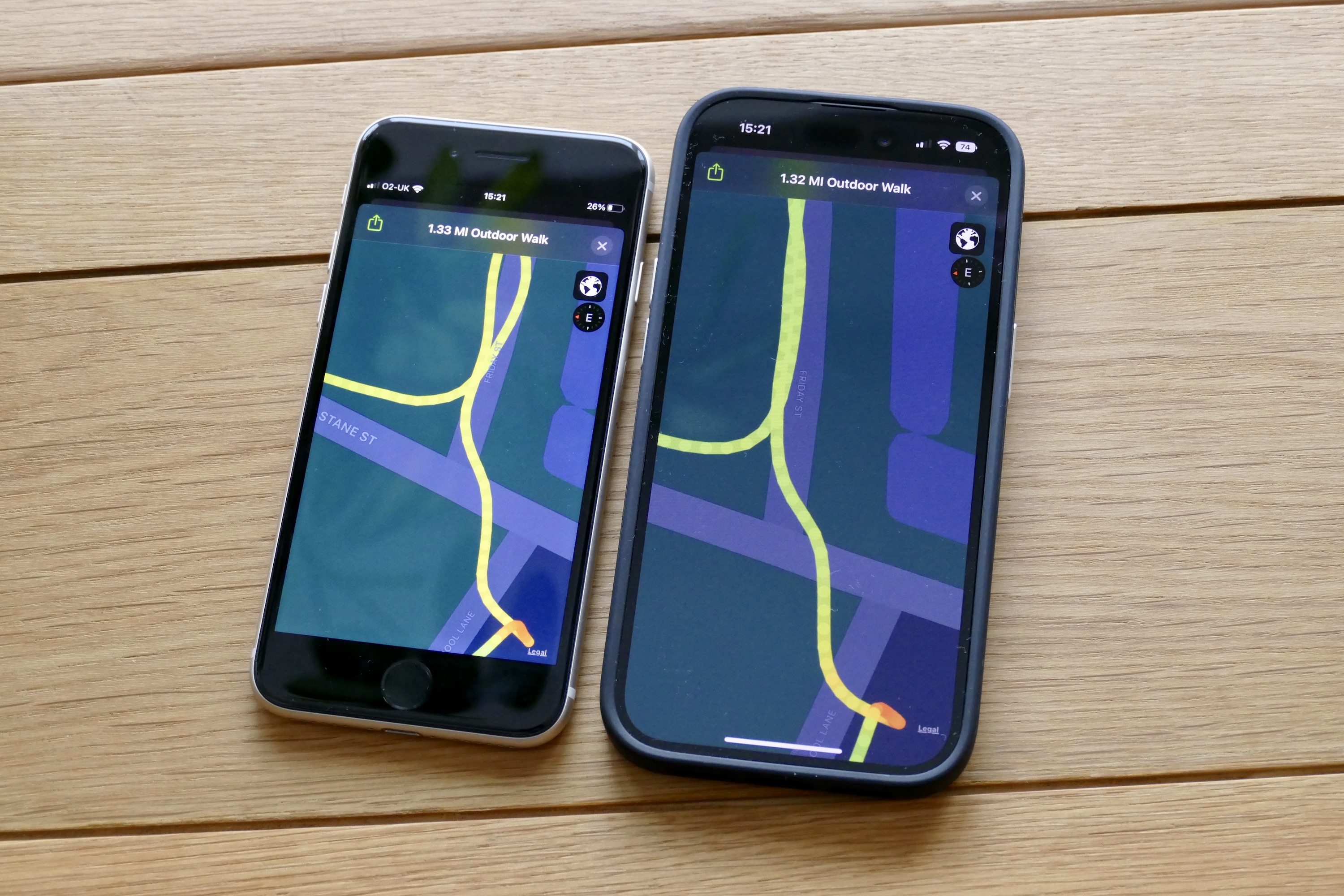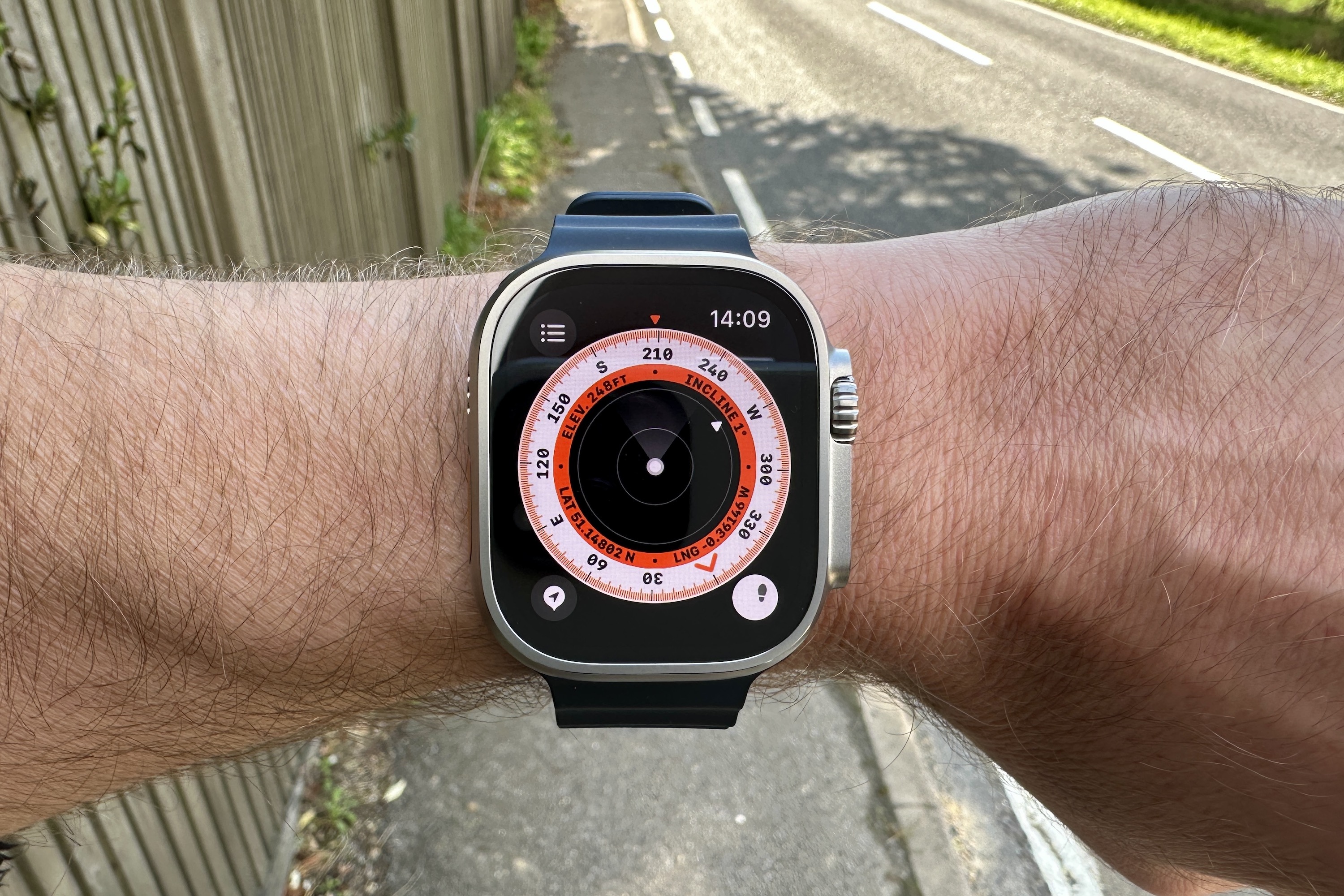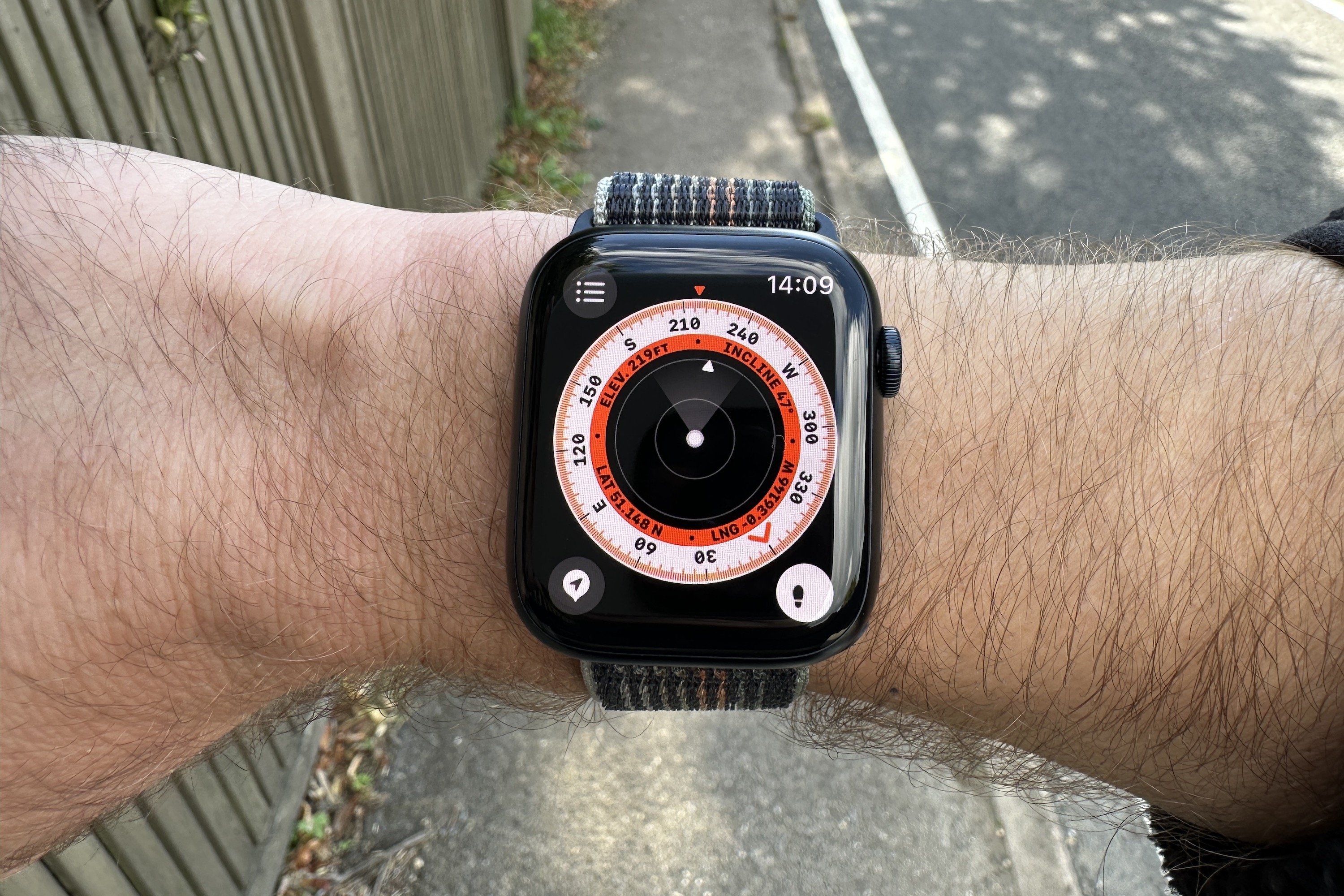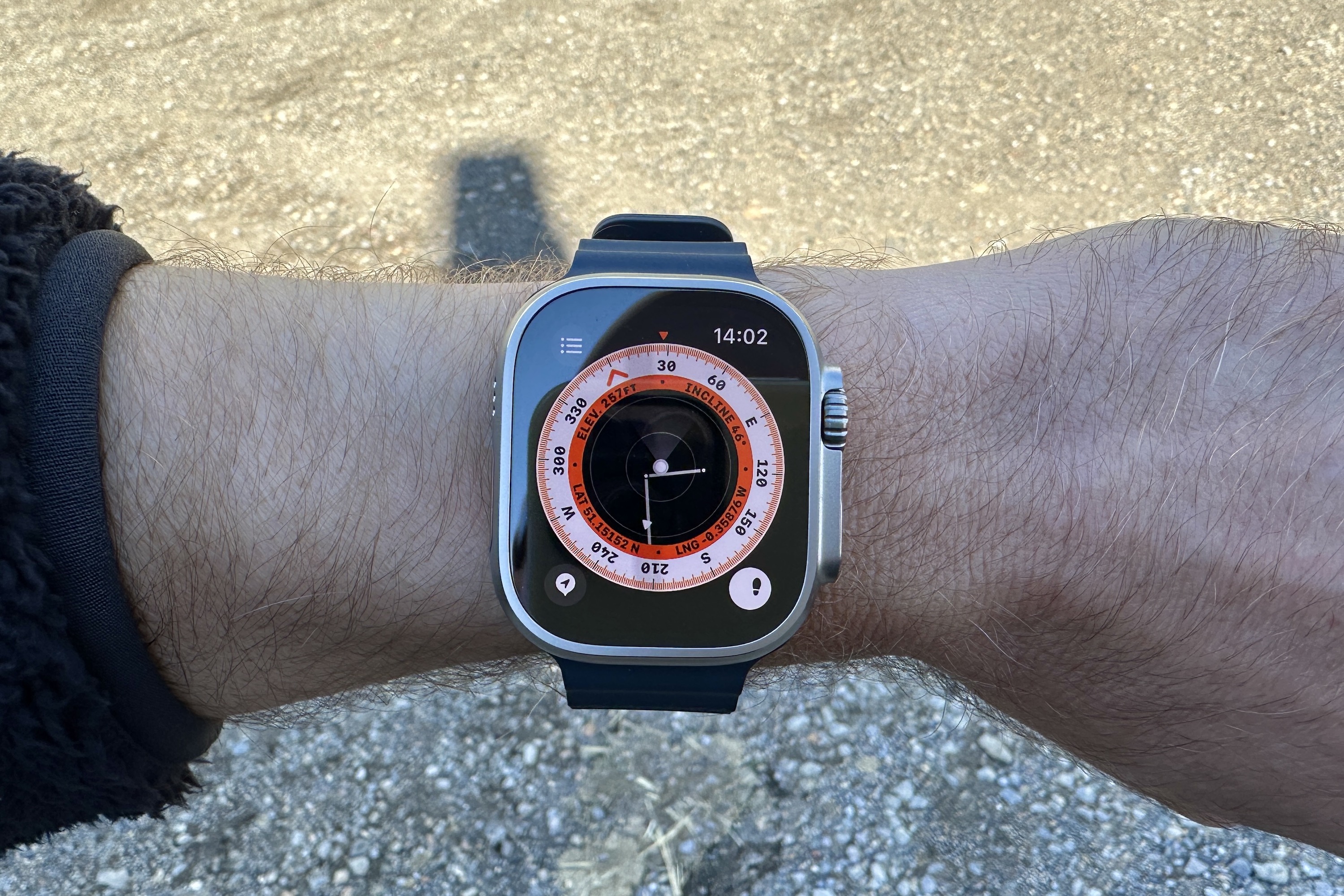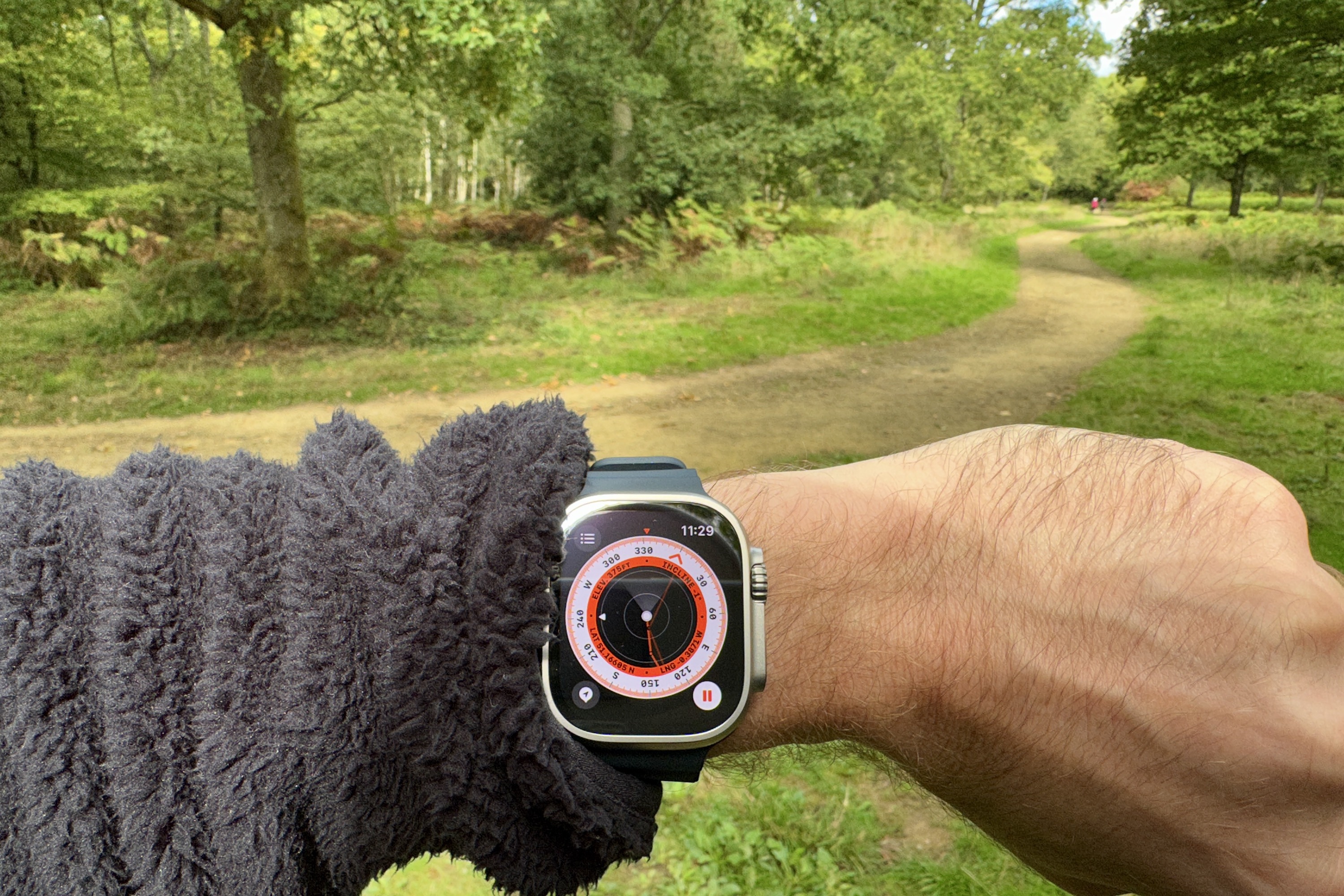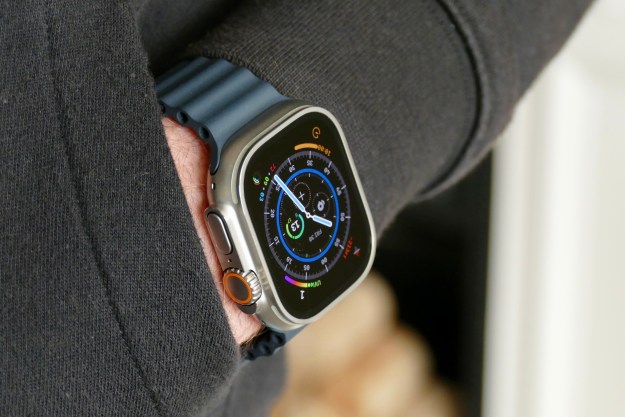
“The Apple Watch Ultra's expertly made special features give it surprisingly wide appeal, with the long battery life and characterful, luxurious design making it a fantastic choice even for those not planning any daring adventures.”
- Highly durable build
- Luxury materials
- Three-day battery life
- Expertly judged special features
- Characterful design
- Does everything the Series 8 does
- LTE as standard
- Twice the price of the Series 8
Apple makes amazing products almost anyone can pick up, use, and enjoy. When you first hear about the Apple Watch Ultra, however, it doesn’t sound like it’s for everyone. It’s for those few with $800 to spend on a smartwatch that’s seemingly only supposed to be used in the sea, up a mountain, or covered in mud in a bog. Or is it?
- About our Apple Watch Ultra review
- Apple Watch Ultra: design
- Making the Apple Watch Ultra more comfortable
- Apple Watch Ultra: fitness tracking
- Apple Watch Ultra: Wayfinder face and compass app
- Apple Watch Ultra: Backtrack
- Apple Watch Ultra: screen, software, and performance
- Apple Watch Ultra: battery
- Apple Watch Ultra: Low Power Mode
- Apple Watch Ultra: price and availability
- Apple Watch Ultra: verdict
I’ve not been anywhere like that during my time with the Apple Watch Ultra, and I think it’s one of the most exciting, technically impressive, and most characterful products Apple has ever made. You’re skeptical, aren’t you? Allow me to explain.
About our Apple Watch Ultra review
I have used the Apple Watch Ultra since it launched, and the majority of the review is based on that initial period with the smartwatch. Since then, I’ve continued to wear it, and updated the review with new observations and comments on new features. The good news is, my overall opinion has not changed, and it remains a 5/5 product.
Apple Watch Ultra: design
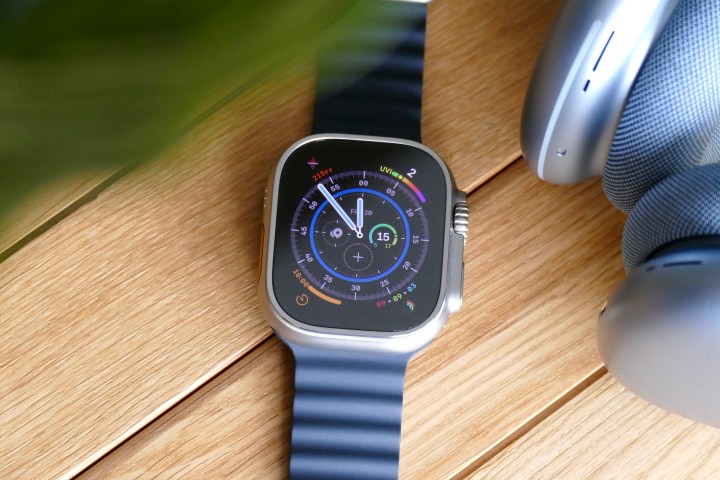
The Apple Watch Ultra is quite big. The 49mm by 44mm by 14mm case is larger than the Apple Watch Series 8 and Watch SE 2, but it’s not all that different from the 45mm x 45mm x 10mm Galaxy Watch 5 Pro, or seriously sporty smartwatches like the 46mm x 46mm x 14mm Garmin Forerunner 955. If you’ve got slim wrists, it’s going to look gigantic, but not because it’s badly proportioned — no, it’s because the watch is so large. I’ve compared the size with other large watches to give you an idea of whether it’s going to suit your wrist or not.
However, the Apple Watch Ultra is recognizably an Apple Watch, just chunkier. It’s as if the Series 8 has been reimagined by Tonka. Retaining the now-classic Apple Watch shape is the right decision, as — despite the size and 61-gram (95-gram with the band) weight — it’s very comfortable to wear. The sharpness of the bezel isn’t repeated anywhere the watch touches your skin, where that familiar curved case ensures it never prods or pokes uncomfortably.
The button and Digital Crown guard don’t dig into your wrist either, which is even difficult for some large traditional watches to avoid. My watch has the Ocean Band, and I have found it perfectly wearable. I chose it because I wear dive watches a lot, and I particularly like Seiko’s supplied rubber straps. This has the same degree of flexibility, doesn’t get hot, and allows for masses of adjustments to make it suitable for all wrists and to wear over a wetsuit.
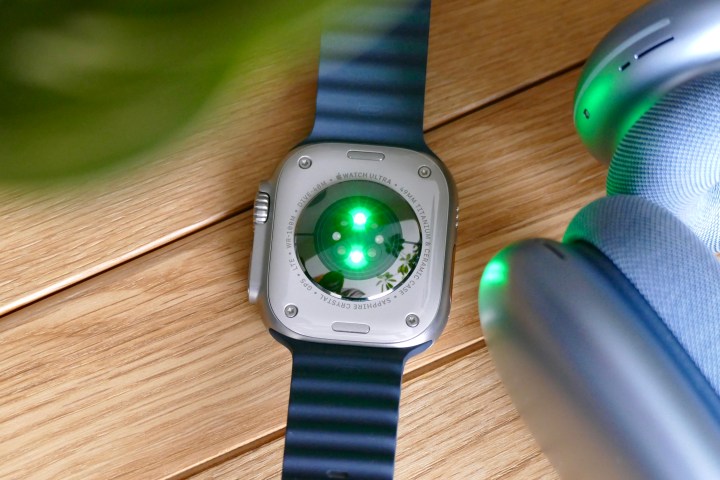
On the opposite side of the case from the Digital Crown is the new, bright orange Action Button. By default, it activates the Workout mode, but it’s surprisingly customizable, with the stopwatch, torch, and dive modes as other options, in addition to adding a waypoint when using GPS. If you keep the default setting, you can also set the button to start a specific workout, bypassing the usual countdown.
Also activated with the orange Action Button is the emergency siren, which Apple says can be heard up to 180 meters away. It’s a shrill, escalating, unpleasant sound rather than a copy of Apple’s Radar or Alarm ringtones. A friend who heard it said it’s such a hateful noise that it would make him head in the opposite direction just to get away from it, so it’ll definitely get some attention if you set it off in Starbucks. Set it off in the wilderness, and no one will think it’s being activated for fun, and that’s exactly what you want.
The finely grained titanium case, sapphire crystal, and ceramic case back give the Apple Watch Ultra luxury credentials as well as toughness, which is enhanced further by the IP6X dust resistance and 100-meter water resistance. It has also been tested to MIL-STD 810H standards. It feels like it’s built to last, and looks like it’ll take a considerable beating.
When you turn off the Water Lock after the watch has been in the water, it fizzes and whirs as it spits out any unwanted droplets, giving it a surprisingly mechanical feel — like it’s almost alive. It’s still a smartwatch, but this, along with the purposeful looks and go-anywhere attitude, gives the Apple Watch Ultra a surprising amount of character. That character (and the size) made me wear it with my sleeve tucked behind it, showing it off, something I didn’t really do with the Apple Watch Series 7.
All this led to the realization you could actually bond with the Apple Watch Ultra, especially if you end up sharing adventures with it over time. I really never expected to think that about a smartwatch, and it speaks volumes about what Apple has created here.
Making the Apple Watch Ultra more comfortable
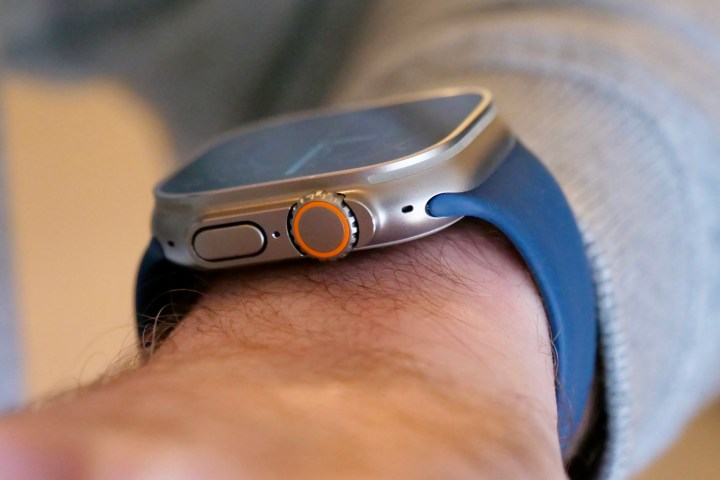
I’ve worn the Apple Watch Ultra with the Ocean Band it came with since launch, but recently wanted to make it a little more comfortable to wear all day, every day. There’s nothing wrong with the Ocean Band, but it’s chunky enough that it can get in the way when you’re not adventuring, and it takes up a lot of room under my cuff.
The solution was to pair the Apple Watch Ultra with the rubber Solo Loop. In doing so, I found it suited the smartwatch far more than I expected. The lines work, and it makes it much more comfortable to wear for extended periods. It didn’t entirely disappear on my wrist, but it definitely became less noticeable, as the overall weight dropped to 75 grams.
Apple doesn’t list the Solo Loop as being a band “made” for the Apple Watch Ultra, but don’t dismiss it because of this. I’ve worn the combination for more than a week now, and it’s the way I’ll continue to wear the Apple Watch Ultra. At $50, the Solo Loop isn’t one of the expensive official Apple bands either. Try it, and I think you’ll be pleasantly surprised.
Apple Watch Ultra: fitness tracking

Open the Workout app either with the usual icon or by using the Action button to see a cool flash of orange on the screen to signify it’s transporting you directly there. You’ll find the same workout modes and system WatchOS 9 offers on other Apple Watch models.
If you track a run, it displays heart rate zones (based on its own algorithm, or you can manually set them yourself), while the general overview can be modified to show stride length, vertical oscillation, and ground contact time. While this information is not exclusive to the Watch Ultra, the larger smartwatch lets you see six different data sets on the screen at one time, making it more informative at a glance.
Operation of the watch’s workout features is also the same as the Series 8 and Watch SE 2. The workout modes are varied and easy to access, and all the relevant data is shown on the big, bright screen. I can see the time, check my heart rate, and quickly jump between it, the compass, and other apps without any slowdown. When you open the Dock using the side button, the compass app even starts working in the helicopter view. It’s all so slick and simple.
The Apple Watch Ultra uses both L1 and L5 GPS antennas to better lock onto satellites and provide more accurate location data. I compared the performance of the Watch Ultra (connected to an iPhone 14 Pro) against that of the Apple Watch Series 8 (connected to an iPhone SE (2022) to see if there were any obvious differences. The Apple Watch Ultra recorded a more linear and logical route, whereas the Series 8 showed me wandering more, which I didn’t really do. It’s not much of a difference, but I think it’s there, so in my anecdotal tests, the Watch Ultra’s GPS does appear to be more accurate.
The maps produced in Apple’s Fitness app are detailed, with helpful colors along the route to show your pace, and you can zoom right in to see almost exactly where you walked, ran, or cycled. Compare it to the mapping in the Samsung Health app, and there’s definitely more detail in the Fitness app, but whether it’s truly helpful may depend on your needs.
I still find the split between Apple’s Health app and Fitness app confusing, and would really prefer a single app to handle everything, plus the information presented isn’t as detailed as apps from Garmin or even Samsung. While the Apple Watch Ultra may be more hardcore, the apps and data presented in them aren’t any different from the Series 8 or Watch SE 2, so if you’re just going to track simple workouts. there’s no software advantage to owning the Watch Ultra. It doesn’t mean you shouldn’t, just don’t expect it to offer much more for the casual exerciser.
Apple Watch Ultra: Wayfinder face and compass app
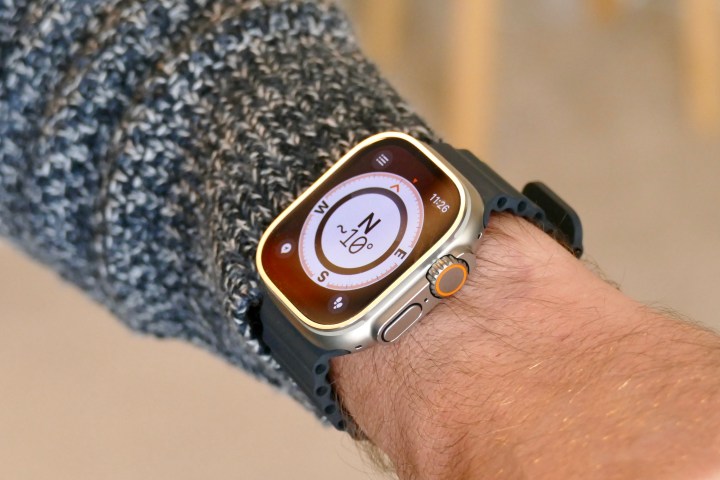
It may seem strange to dedicate an entire section to a watch face and compass, but these two features demonstrate how beautifully integrated everything is in WatchOS 9, and where the Apple Watch Ultra stands out against the other Apple Watch models.
The Wayfinder watch face is exclusive to the Watch Ultra and is hugely customizable. The bezel can show elevation and incline or latitude and longitude, plus there are eight complications to set, meaning you have tons of information ready at a glance. While the completed face is busy, it’s not confusing thanks to the very clever, readable, watch-like design and option to change various colors. It also really suits the Watch Ultra. Plus, the Night mode — activated using the Digital Crown — looks amazing when it turns the entire face red. I’ve left it on that mode a lot just for its cool sci-fi looks.
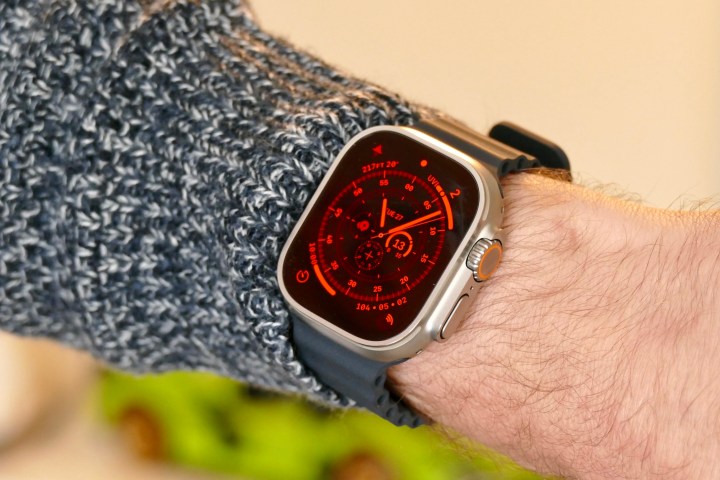
The beautifully designed compass is a separate app and part of the Wayfinder face, plus it can be added as a complication for quick access. It updates constantly as you alter direction, there are buttons to mark a waypoint and activate the Backtrack feature, and a tab that provides a greater level of detail. Twist the Digital Crown, and you can not only change what’s shown on the screen, but also see a larger map view in the center of the compass.
I wanted to single these out because I’ve not changed the Wayfinder watch face yet. I haven’t felt the need to, and it’s the first time I’ve ever wanted to use a compass app. And then when I did, I was actually impressed by it. I think they both sum up Apple’s minute attention to detail here. The deep integration is what makes WatchOS 9 such a pleasure.
Apple Watch Ultra: Backtrack
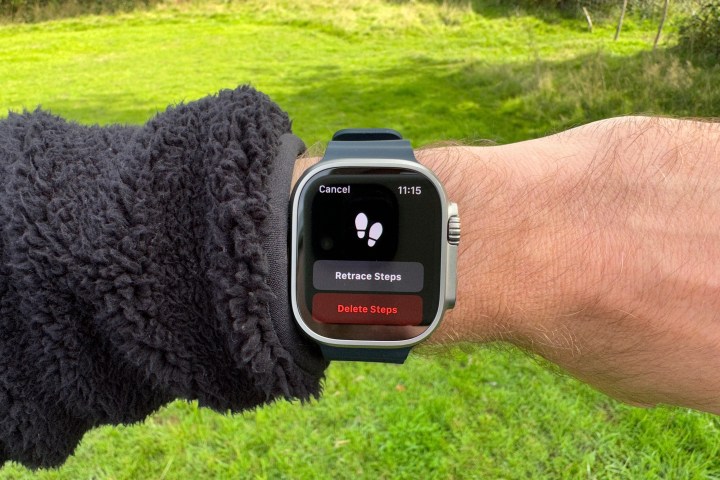
What about the Backtrack feature? It’s activated from the Compass app, where all it takes is a single tap on the little icon shaped like two feet. If you use the Wayfinder watch face, there’s instant access to the compass using one of the complications. To operate, it does require an additional location setting, called Significant Location, to be switched on (it’s hidden away under Settings > Location > System Services). With this done, Backtrack works away in the background.
You don’t notice it until you need it. Tap the footsteps icon again, and Backtrack will lead you back to where you started in the event you get lost. Except don’t expect it to directly lead you back. Backtrack uses the compass app, where a small arrow points you in the right direction, rather than retracing your steps exactly. It’s as the crow flies, which does mean you still have to make decisions along the way.
For example, at a junction, Backtrack showed I should go in a different direction than the way I came, which I knew would still absolutely return me to my starting point, but not in the way I arrived at the point originally. You’ll have to bear this in mind and trust both your instincts and the Watch Ultra’s compass. Depending on the terrain, this could mean encountering situations where you may have to backtrack on Backtrack.
The feature is very simple to use. I didn’t notice any additional battery drain when using it compared to when I’m not. And because it works through the Compass app, it’s available regardless of the fitness-tracking app used, so it’s very versatile. This is a different approach to Samsung’s similar feature, where you have to use a GPX map in order to use the Route Back feature on the Galaxy Watch 5 Pro.
If Backtrack sounds like something you’d use or would like to have in reserve, remember it’s a WatchOS 9 feature and also available on the Series 8 and the Watch SE 2. Testing it back-to-back with the Series 8 revealed that the Watch Ultra’s stronger GPS gave more precise directions. While the Series 8 would still have gotten you back, the Watch Ultra was clearly the more accurate of the two. In some situations, those few degrees may make a lot of difference. You can see the variations in the gallery above, just look for the white marker on the inner bezel.
Apple Watch Ultra: screen, software, and performance
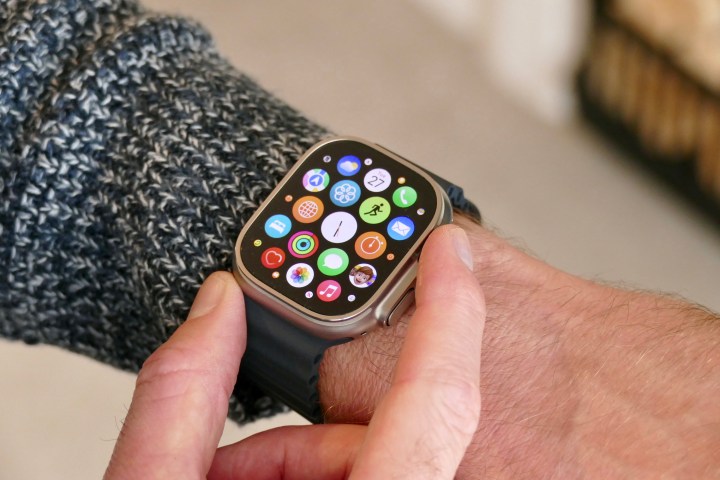
Like the iPhone 14 Pro, the Apple Watch Ultra’s Retina LTPO OLED screen can suddenly boost the brightness to 2,000 nits in sunlight — and it’s highly effective. It’s so noticeable that it’s like you flicked on a light switch. The flat sapphire crystal doesn’t affect viewing angles as I feared, but it is susceptible to reflection.
It’s sharp and colorful too, but with a 1,164 square-millimeter viewing area, it’s not all that much bigger than the 45mm Series 8’s 1,143 square-millimeter display. The size of the case is more about housing the battery and increasing durability than it is about making the screen larger. However, clever use of the software means that in some situations, you do see more on the screen at one time compared to the Series 8.
Apple’s WatchOS 9 is installed just like it is on the Apple Watch Series 8 and the Watch SE 2. The software is fluid, logical, and reliable. I prefer not to overload it with apps (which helps minimize distractions) and rely on the standard apps and few choice additions most of the time. Apps of all types load and operate quickly, and the App Store is a joy to browse thanks to sensibly sized icons and clearly organized sections.
The Apple Watch Ultra does everything the Series 8 can do and so much more.
The powerful S8 processor is also the same one inside the Series 8 and Watch SE 2, the haptics are wonderful — especially when you twist the Digital Crown or when an alarm sounds — and the speakers are seriously loud too. Apple Pay works seamlessly and is really easy to set up. I don’t have any plans to try the crash detection or fall detection, but I’m pleased they are there. I feel similarly about warnings about my health from the electrocardiogram, heart rate sensor, and blood oxygen monitoring features.
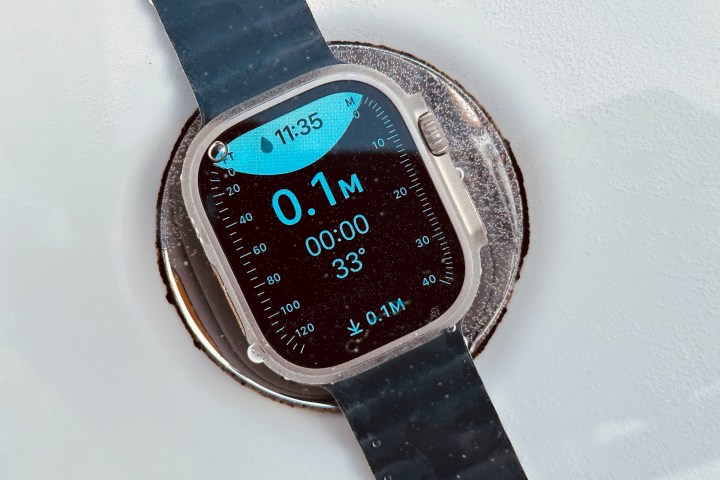
I haven’t been able to try all the features on the Watch Ultra. I don’t dive, so the most I’ve done is submerge the watch in the sink, where it automatically activated the easy-to-read dive gauge with water temperature readout. A special version of the Oceanic+ app is available for the Watch Ultra, and it allows you to plan dives, use the compass, and get more in-depth safety and experience features. Apple says the Watch Ultra is aimed at Professional Association of Diving Instructors (PADI)-qualified divers to a depth of 40 meters. I compared the app to the G-Shock Frogman’s dive computer here.
The Apple Watch Ultra does everything the Series 8 can do and so much more, adding a wealth of niche features and durability. Then, to make sure you can enjoy every bit of the smartwatch for longer, it pushes one key aspect further ahead — which we’ll come to next.
Apple Watch Ultra: battery
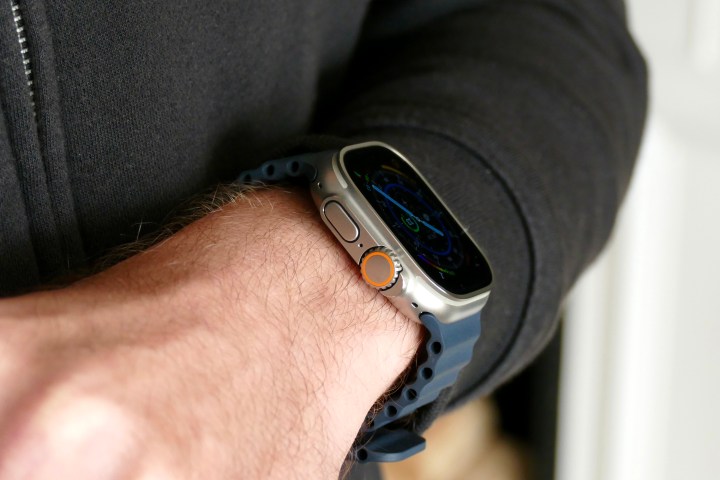
The Apple Watch Ultra’s battery has a 76% larger capacity than those in the Series 8 and Watch SE 2, and Apple claims the battery will last for 36 hours on a single charge without a cellular connection — twice what you should expect from the other models. The good news is it’s not bluster; the Apple Watch Ultra’s battery life is excellent.
Here’s an example. I recharged the battery on its second cycle at 9 a.m. on Tuesday, then used it normally each day. I left it switched on overnight and tracked two indoor workouts, plus a one-hour walk and a 30-minute walk with GPS and Backtrack engaged, over the course of the next few days. At 6 p.m. Thursday, there was still 10% remaining — so I turned on the Low Power mode, and it still had 5% left at 11:30 p.m. On my first days of use, the battery lasted for three full days without as much GPS use.
The Apple Watch Series 7 regularly returned two days of use on a single charge, but that was only with turning it off overnight. To get up to three full days of use from the Watch Ultra with its brighter screen, plus all its extra ability, is great — and a genuine reason to buy.
How does this compare with the competition? Samsung’s rival smartwatch, the $450 Galaxy Watch 5 Pro, also lasted for three days without a recharge, but it did so only if you didn’t track sleep. However, like the Watch Ultra, it’s a big, heavy watch and not really suitable for wearing overnight anyway.
The longer battery life really sets the Apple Watch Ultra apart from its sibling smartwatches.
However, while the Watch Ultra’s battery is good, it can’t beat the marathon battery life provided by dedicated running or activity smartwatches. The $600 Garmin Forerunner 955 Solar’s battery is good for two weeks, and even the smaller, more design-led $180 Vivomove Sport’s battery will last for five days. The Apple Watch Ultra’s battery is powerful for an Apple smartwatch, but in the wider world of high-performance activity smartwatches, it still falls behind.
Should this be a concern? How much this will impact your everyday life depends on what you do in your everyday life. If you regularly run hundreds of miles, hike each weekend, and don’t always have access to power (or intend to use the GPS and Cellular connection every day), then the Apple Watch Ultra will still need charging every couple of days. But if you do these activities every so often, then you’ll spend a lot less time visiting the charger than you would with a Series 8, and three days of use between charges is entirely achievable. The longer battery life really sets the Apple Watch Ultra apart from its sibling smartwatches, and it’s a strong reason to buy this model over any other.
Apple Watch Ultra: Low Power Mode

As part of watchOS 9.1, Apple introduced Low Power Mode on the Apple Watch. The Watch Ultra already has great battery life, but with Low Power Mode, it’s expected to increase to 60 hours in some situations. I put this to the test and was impressed with the results as they surpassed expectations.
Using the Apple Watch Ultra fairly normally, with notifications, some light activity tracking, and controlling music, the battery lasted for five days before it needed recharging. This was without GPS or cellular, and the Low Power Mode switches off the heart rate tracking. The watch definitely isn’t working hard, but this is still a lot longer than even Apple indicates.
What it does is make the Apple Watch Ultra even more versatile. I took the smartwatch away for a long weekend, and even without Low Power Mode, it was still operational (without sleep tracking) on the third day. I could have switched on Low Power Mode at that point and extended the battery life for a couple more days, with only a small drop in usefulness. The Apple Watch Ultra continues to be a battery monster, even six months into its life.
Apple Watch Ultra: price and availability
The Apple Watch Ultra costs $799, or 849 British pounds. There is only one version of the Watch Ultra, and it comes with LTE connectivity as standard. The only decision to make is about which strap to choose. It’s the Ocean Band you see in our photos, which is mostly designed to appeal to divers. Alternatively, there’s the Alpine Loop for hikers and outdoor enthusiasts, and the Trail Loop for runners and endurance athletes. You can buy the Apple Watch Ultra now through Apple’s online and retail stores.
This is an expensive watch, but there’s unquestionable value here. Titanium, ceramic, and sapphire crystal all add to the price, plus there’s a massive amount of research and development involved in getting the additional features in place and working correctly. It’s more expensive than a Series 8, which has a lot of the same core functionality, but not vastly more so than many competing high-performance activity smartwatches from Garmin, Suunto, Polar, or Coros. It’s not even that different from the cost of a midlevel traditional diver or field watch from brands like Seiko, Citizen, Casio, or Hamilton.
Apple Watch Ultra: verdict

While I’ve been using and writing about the Apple Watch Ultra, I’ve called it simply the Apple Watch on more than a few occasions. When I began to give this some thought, it seemed appropriate. The Apple Watch Ultra is clearly the beginning of something new for the company, rather than a one-off or the product of a lazy marketing campaign. What Apple has done with the Watch Ultra is to make it genuinely different from the Series 8 in almost every respect. Not better or worse, but something that stands on its own.
This is the way you should be thinking about it before you buy it. It’s not really an alternative to the Series 8 or Watch SE 2 despite being closely related. It serves different purposes, has its own strengths and weaknesses, and has a series of unique features that wouldn’t fit on a Series 8. You will buy this instead of the Series 8.
The surprising thing is, the Apple Watch Ultra is quite easy to justify. The long battery life is a huge selling point that everyone will appreciate, as is the absolute bulletproof nature of the build and materials. Plus, if you do anything remotely adventurous, it’ll easily keep up all day long. But the thing I didn’t expect was to connect with it personally. It has a character all of its own, and that’s something very few smartwatches accomplish. What’s more, the new features and the simplicity of use is rather inspirational and encourages you to go out and give them a try.
Against the odds, Apple has made a rugged smartwatch that non-rugged people will want to own — and they’ll be very pleased with it when they do. It’s a fantastic start of something really exciting and really different for Apple’s superb smartwatch range.
Editors' Recommendations
- The Galaxy Watch 6 may fix one of the Galaxy Watch 5’s biggest mistakes
- Watch the Galaxy S23 Ultra and iPhone 14 Pro Max face off in brutal drop test
- Your Google One plan just got 2 big security updates to keep you safe online
- Have a Pixel Watch? You need to stop using one of its most important features
- The best Samsung phones in 2023: our 8 favorite Galaxy phones

